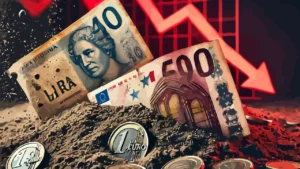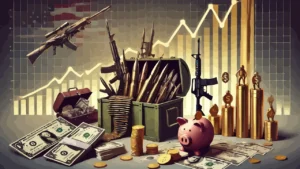Gold has historically been considered a safe haven, that is, an asset that investors buy in times of crisis to protect their capital. However, it is often observed that, when financial markets collapse, the price of gold, instead of rising, decreases.
This phenomenon may seem counterintuitive: if confidence in the stock markets falters, one would expect an increase in demand for gold. However, the financial reality follows more complex dynamics. In this article, we will analyze the main reasons behind this apparent contradiction.
Disclaimer:
The information provided does not constitute a solicitation for the placement of personal savings. The use of the data and information contained as support for personal investment operations is at the complete risk of the reader.
Contents
#1. Liquidity and forced selling
When stock markets crash, many investors find themselves having to cover losses on other assets, especially those with leverage. This forces them to sell any liquid assets they have, including gold and precious metals. This mechanism is called a margin call: if an investor has bought shares on credit and they lose value, the bank or broker will require additional collateral or the sale of assets to cover the loss. Gold, being an easily liquidated asset, often ends up in the vortex of forced sales.
Furthermore, in times of severe crisis, financial institutions and hedge funds often hold positions in assets considered safe, including gold. However, when they need immediate liquidity to cover losses on other financial instruments, they are forced to sell gold as well, putting downward pressure on the price. This explains why, in the initial moments of a market crash, even a When markets crash, the price of gold can fall due to forced selling for liquidity, the appreciation of the dollar and financial speculation. Although gold fluctuates in the short term, in the long term it maintains its role as a store of value, especially in times of economic uncertainty.a safe haven like gold can depreciate.
#2. The dollar and US Treasuries
During market crashes, many investors seek safety in assets that are considered even safer than gold: U.S. Treasury bonds and the U.S. dollar. If demand for dollars increases, the price of gold, which is quoted in dollars, tends to fall. Furthermore, if bond yields rise, gold, which does not offer interest, becomes less attractive compared to financial instruments with a guaranteed return.
When a financial crisis hits, global investors tend to flee to the U.S. dollar, which is considered the world’s safest currency. This flight to the dollar leads to its appreciation against other currencies, making gold more expensive for those buying it in other currencies. Additionally, the Federal Reserve and other central banks can intervene by raising interest rates to stabilize markets, which makes Treasuries more profitable and reduces the attractiveness of gold.
Another key factor is that, in times of financial panic, institutions and governments accumulate dollar reserves to ensure stability. This creates temporary demand for the greenback that penalizes precious metal prices. So, while gold tends to be a safe haven in the long run, in the short term it can be less attractive than the dollar and U.S. Treasuries.
#3. Speculation and the price of gold
Gold is not only a safe haven, but also a financial asset subject to speculation. Many institutional investors buy and sell gold based on market conditions, without necessarily considering it as a long-term safe haven. If the general expectation is for panic, those who hold speculative positions in gold may decide to liquidate them, contributing to a decline in the price.
Large mutual funds and hedge funds often use derivatives like gold futures to bet on its price movements. When markets fall, these investors may decide to sell their gold positions to avoid losses on other assets or to take advantage of more profitable buying opportunities elsewhere. These types of movements can exacerbate gold’s fluctuations, temporarily pushing its price down.
Small investors also contribute to this dynamic: when they see markets crashing and notice that gold is not rising as expected, they can panic and sell, further contributing to the price decline.
#4. Financial crises and low correlation
Financial crises often generate extreme but temporary price movements. After a crash, gold may initially lose value, but then recover over time as investors seek safe havens to protect their wealth. If the crisis is prolonged or results in high inflation, gold tends to recover, as it holds its value over the long term.
Many past financial crises have shown that gold’s short-term movements are often driven by the immediate need for liquidity rather than its role as a store of value. However, in the long run, gold tends to benefit from expansionary monetary policies adopted to counter crises, such as printing money and lowering interest rates, which make it more attractive than fiat currencies.
Another aspect to consider is the low correlation of gold with other financial assets. Historically, gold has shown a negative correlation with stock markets during prolonged periods of economic crisis, but it does not always react immediately to a market crash. This depends on macroeconomic factors, monetary policies and investors’ perception of the future prospects of the markets. Although in the short term it can fluctuate, in the long term its function as a store of value tends to reassert itself, especially in contexts of economic and political uncertainty.
👉 Read also: Correlation Between Gold and Other Asset Classes











Leave a Reply